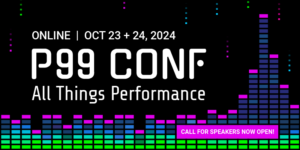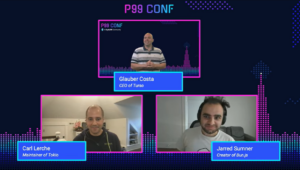Given that Gil Tene was a key inspiration for the very creation of P99 CONF, we were thrilled to have him join us for P99 CONF 2022. And given that Gil is quite famous for an “oh sh*t” talk on how NOT to measure latency, we expected that his P99 CONF talk would lie at the rare intersection of illuminating, startling, and engaging. Gil did not disappoint.
From Dr. Strangelove to sacrificial goats, Gil took the audience on a journey that ranged from high latency peaks to a trough of latency measurement despair. He deconstructed what we’re really looking at with “all the pretty charts,” and, more importantly, what we’re missing. At what seemed to be the bottom of the trough of despair, Gil showed a rather terrifying example of how actions that seem to improve performance (on a chart) can seriously undermine the end user experience (in reality). Misery indeed.

But Gil remains confident that it is in fact possible to overcome the shortcomings of our accepted performance measurement methodologies…just not in the way he originally believed we could. There’s hope in misery. A light at the end of the tunnel. Rainbows, even (perhaps because Gil was joining us from Hawaii). As it turns out, engineers can prevent misery by learning to love misery. If you missed it during the event, just grab the red pill and watch his session on demand.
Following his keynote, Gil joined us in Speaker’s Lounge to continue the lively conversation – ranging from communicating the business value of performance impacts, to major technology shifts that Gil has witnessed over the past two decades, to what’s new – and what’s next – for Java.
A Tour of the Talk
- 0:17 On delivering a P99 take down at “P99 CONF”
- 1:41 What misery metric does Gil love the most
- 3:29 How do you “sell” performance to the business
- 4:55 Common approaches to compensating for inefficient systems
- 7:23 What’s changed in technology over the past 20 years
- 9:52 The advantages of Java 19
- 12:26 Java projects: Amber, Valhalla, and Panama
- 13:46 The business value of the latest Java features
- 16:10 Communicating performance impacts to the business
- 17:09 On the survival of extremely old versions of Java
- 19:46 Why watch Gil’s keynote
Teasers
Here’s a taste of the many memorable moments:
It’s often hard to convince people [that performance] is broken, that the broken part matters. All the mismeasurement and mischaracterization practices stand in the way because people get these blinders on and say, “Yeah, I understand you’re saying there’s a problem – but look, the P99 is pretty good.” Well, that 99 doesn’t measure actual experience. And are you okay, with losing one half of a percent of your customers every hour? You won’t have many left by the end of the day. Measuring the good rather than the bad, I think, makes it harder to have a conversation about why the bad matters.
***
I don’t think there’s some big moment in time where one day we woke up and the world was very different. But if there’s one thing that I think has dramatically shifted, it’s the shift to running in cloud environments. …I lived through a world where when you needed capacity, it took you three months to get it – if you were lucky – because you had to convince people to put in a budget, order the machines, somebody had to put them in a rack and connect them to networking, then you needed to go through multiple layers of acceptance tests before you were lucky enough to turn the damn thing on. These days, you can turn on a serverless container in under a second. More importantly, lots of technical people are empowered to do that. To me, that shift is very dramatic.
***
I think percentile measurements are so abstract and so far away from business results that it’s hard to know what bad things happen if a certain percentile is bad. There’s no great answer for that.
***
If you’re interested in the real implications of measurement, of performance benchmarking, of monitoring – and a little bit of philosophical thinking on how that ties to the real world and why the real world even works – my session tries to touch on that. If you’re interested in that, please watch it.








